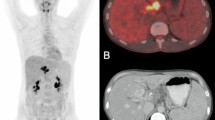Abstract
Background:
Long-term benzimidazole therapy benefits patients with non-resectable alveolar echinococcosis (AE). Methods to assess early therapeutic efficacy are lacking. Recently, AE liver lesions were reported to exhibit increased F-18-fluorodeoxyglucose (FDG) uptake in positron emission tomography (PET). To assess the value of FDG-PET for diagnosis and follow-up of AE patients.
Patients/Methods:
Twenty-six consecutive patients with newly diagnosed AE were enrolled. Baseline evaluation included CT and FDG-PET. Thirteen patients (11 women; median age 50 years, range 40-76) were resected, the remaining 13 (8 women; median age 60 years, range 39–72) had non-resectable disease, were started on benzimidazoles, and CT and FDG-PET were repeated at 6, 12 and 24 months of therapy. Twelve consecutive patients with newly diagnosed cystic echinococcosis (CE) of the liver were also subjected to baseline FDG-PET.
Results:
In 21/26 AE patients, baseline PET scans showed multifocally increased FDG uptake in the hepatic lesions' periphery, while liver lesions were FDG negative in 11/12 CE patients. Thus, sensitivity and specificity of FDG-PET for AE vs. CE were 81% and 92%, respectively. In 5 of 10 non-resectable patients with increased baseline FDG uptake, the intensity of uptake decreased (or disappeared) during benzimidazole therapy, in 3 by ≥2 grades within the initial 6 months.
Conclusions:
FDG-PET is a sensitive and specific adjunct in the diagnosis of suspected AE and can help in differentiating AE from CE. The rapid improvement of positive PET scans with benzimidazole therapy in some patients indicates that absent FDG uptake does not necessarily reflect parasite viability.
Similar content being viewed by others
Abbreviations
- E. multilocularis :
-
Echinococcus multilocularis
- E. granulosus :
-
Echinococcus granulosus
- AE:
-
alveolar echinococcosis
- CE:
-
cystic echinococcosis
- PET:
-
positron emission tomography
- FDG:
-
fluorodeoxyglucose
Author information
Authors and Affiliations
Corresponding author
Additional information
K. D. M. Stumpe and E. C. Renner-Schneiter contributed equally to this work.
Rights and permissions
About this article
Cite this article
Stumpe, K.D.M., Renner-Schneiter, E.C., Kuenzle, A.K. et al. F-18-Fluorodeoxyglucose (FDG) Positron-Emission Tomography of Echinococcus multilocularis Liver Lesions: Prospective Evaluation of its Value for Diagnosis and Follow-up during Benzimidazole Therapy. Infection 35, 11–18 (2007). https://doi.org/10.1007/s15010-007-6133-9
Received:
Accepted:
Issue Date:
DOI: https://doi.org/10.1007/s15010-007-6133-9




